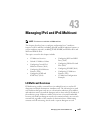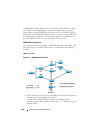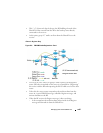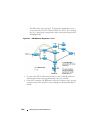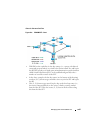
1340 Managing IPv4 and IPv6 Multicast
When Is L3 Multicast Required on the Switch?
Use the IPv4/IPv6 multicast feature on Dell Networking series switches to
route multicast traffic between VLANs on the switch. If all hosts connected
to the switch are on the same subnet, there is no need to configure the
IP/IPv6 multicast feature. If the switch does not require L3 routing, you can
use IGMP snooping or MLD snooping to manage port-based multicast group
membership. For more information, see "What Is IGMP Snooping?" on
page 805 and "What Is MLD Snooping?" on page 807. If the local network
does not have a multicast router, you can configure the switch to act as the
IGMP querier. For more information, see "IGMP Snooping Querier" on
page 807.
If the switch is configured as a L3 switch and handles inter-VLAN routing
through static routes, OSPF, or RIP, and multicast traffic is transmitted
within the network, enabling and configuring L3 multicast routing on the
switch is recommended.
Multicast packets locally routed into a VLAN by the router are flooded to all
ports in the VLAN. Multicast packets ingressing a port that is a member of a
routed VLAN are flooded to all ports in the VLAN other than the receiving
port. It is strongly recommended that multicast routed VLANs only contain
two ports, one on each connecting switch. A VLAN carrying multicast traffic
should never traverse a multicast router, as ingress multicast traffic is L2-
switched across the VLAN, defeating the purpose of the multicast router.
Determining Which Multicast Protocols to Enable
IGMP is required on any multicast router that serves IPv4 hosts. IGMP is not
required on inter-router links. MLD is required on any router that serves IPv6
hosts. MLD is not required on inter-router links. PIM-DM, PIM-SM, and
DVMRP are multicast routing protocols that help determine the best route
for IP (PIM and DVMRP) and IPv6 (PIM) multicast traffic.
IGMP is automatically enabled whenever an IPv4 multicast routing protocol
is enabled that requires it, i.e., PIM-SM, PIM-DM, and DVMRP via the CLI.
Likewise, MLD is automatically enabled whenever an IPv6 multicast routing
protocol is enabled that requires it (PIM-SM and PIM-DM) via the CLI.
IGMP and MLD may not be separately enabled or disabled via the CLI. They
may be separately enabled/disabled via the web.








